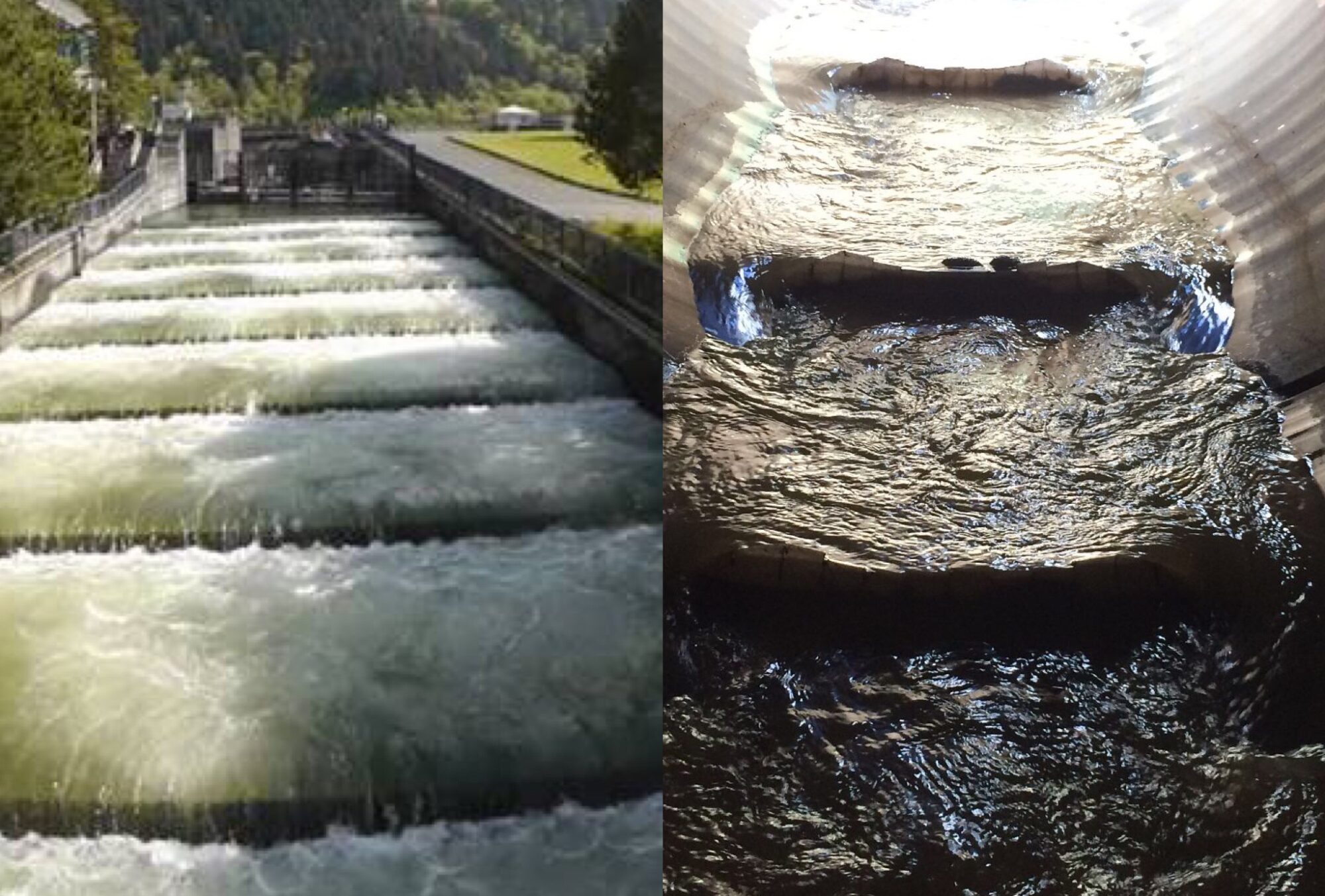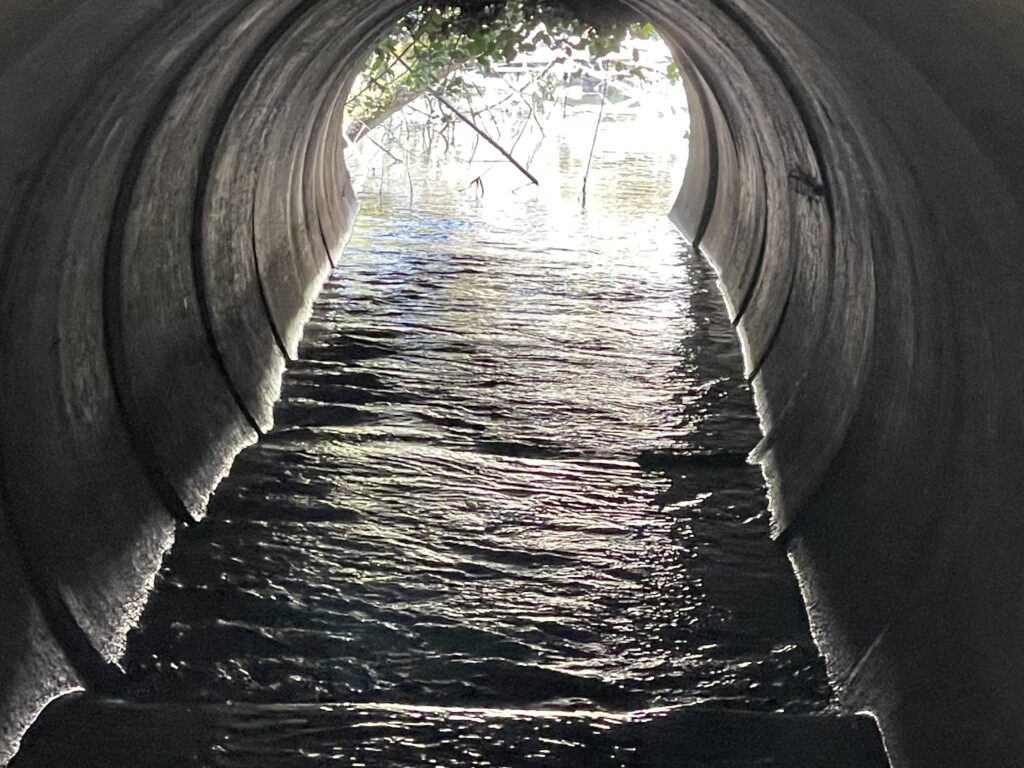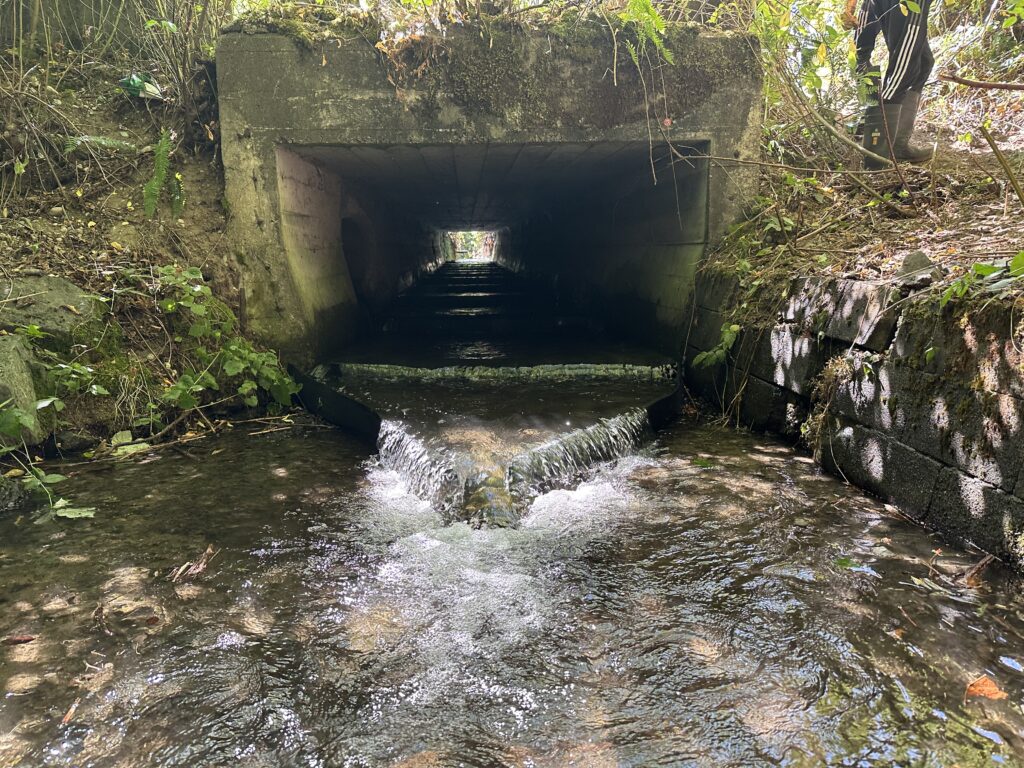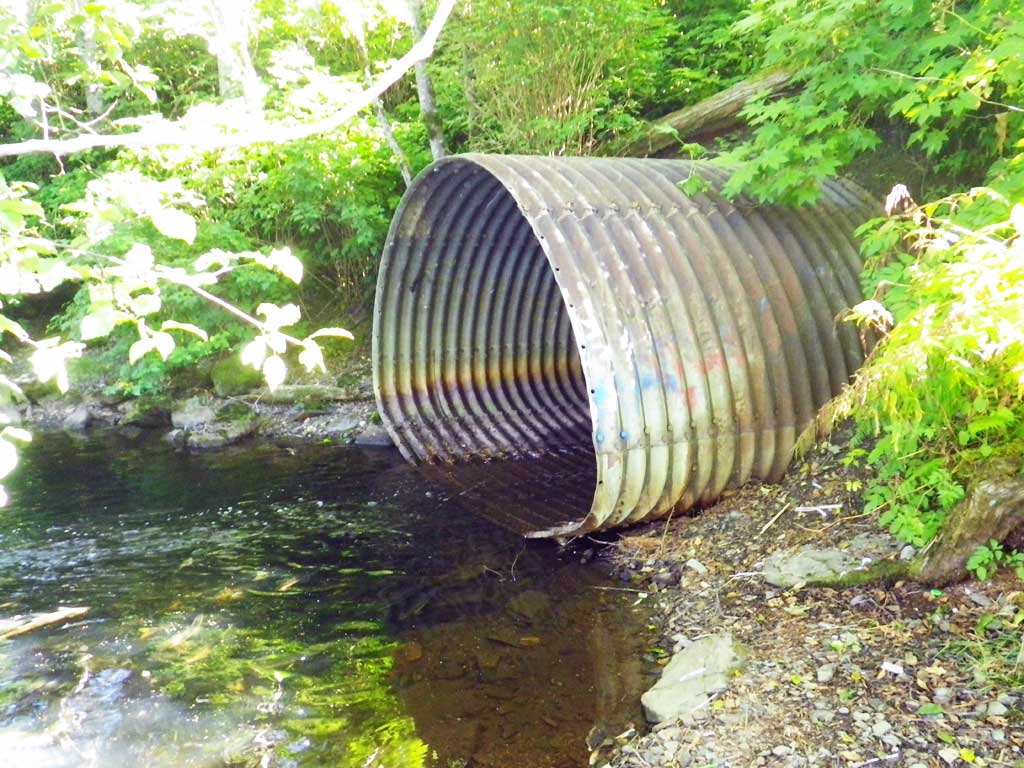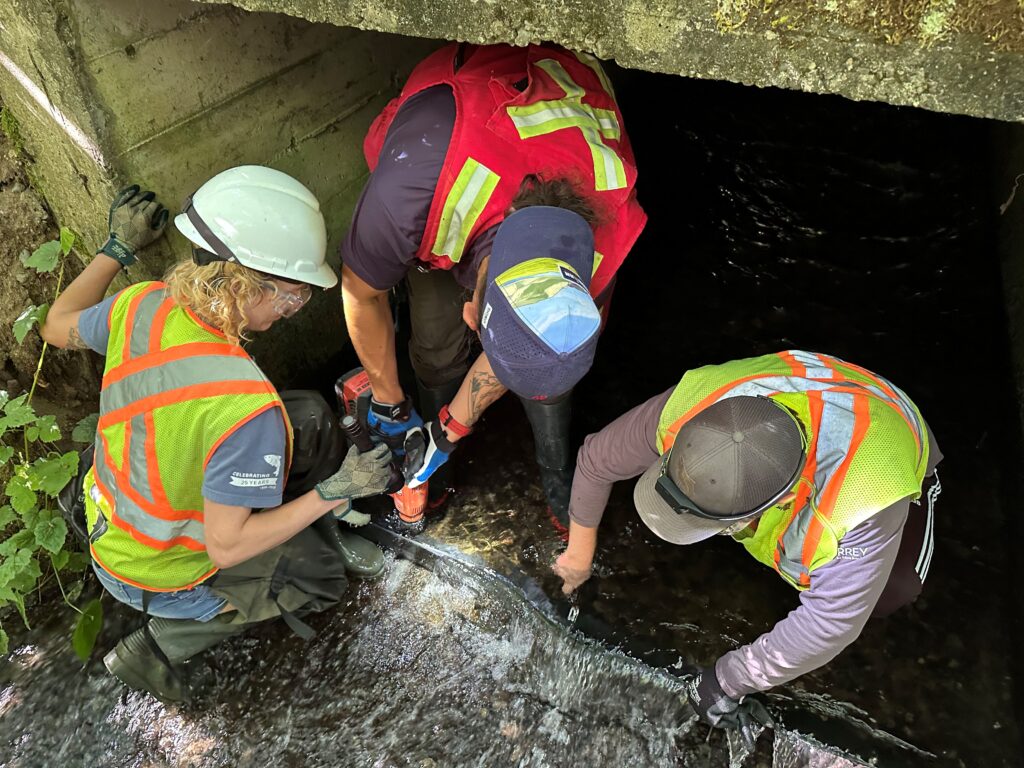Thank you for your interest in learning more about the FlexiBaffle® and how it can be used to improve fish passage in your culvert. These Frequently Asked Questions are intended to address many questions we routinely receive. The first section below provided information on how the FlexiBaffle works to improve fish passage, what it is made from and some examples of existing installations. The second section provided information on the design and installation of FlexiBaffles. If you have any other questions or comments regarding the FlexiBaffle or its use at your project, just click here to contact us!
1. General Information on the FlexiBaffle
What is a FlexiBaffle?
A FlexiBaffle is a flexible weir placed in culverts to enhance fish passage. It increases water depth, reduces water speed and provides resting spots for fish and other aquatic life. The baffle’s flexible design ensures that debris and water can pass through safely during high flows. This maintains the culvert’s hydraulic capacity and minimizes blockages by allowing debris to move through easily.
Reconnect Aquatic Habitat – Naturally…
FlexiBaffles can turn your culvert into a fish ladder!
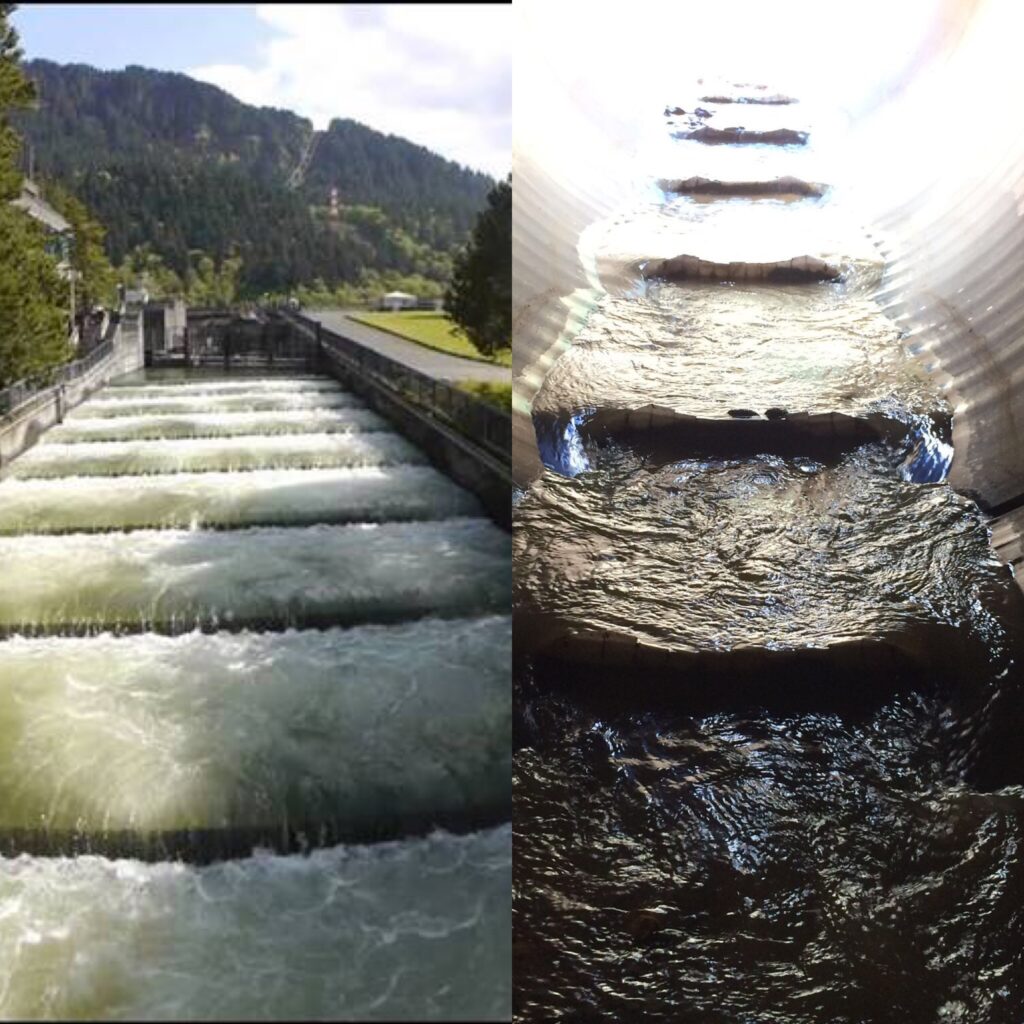
How do FlexiBaffles help fish passage?
Flexible baffles help fish and other aquatic organisms pass through culverts by:
- Reducing water velocity, making it easier for aquatic organisms to swim through culverts.
- Creating resting areas, allowing fish to conserve energy.
- Mimicking natural stream conditions, improving habitat quality inside culverts.
What aquatic species would benefit from the FlexiBaffle?
FlexiBaffles improve conditions for aquatic organisms in your culvert. Culverts are usually built to move water efficiently, which can create fast water currents and shallow depths that hinder movement of fish and other aquatic organisms. FlexiBaffles address this by slowing the water flow and adding complexity to the culvert’s interior, promoting more natural flow patterns. By replicating natural stream conditions around the culvert, they enable local aquatic species—like fish, eels, lamprey, amphibians, reptiles, and invertebrates—to navigate through it successfully.
What are the benefits of the FlexiBaffle versus solid baffles?
- Minimal Flow Restrictions: They flex during high flows to preserve culvert capacity, unlike rigid baffles that reduce culvert capacity.
- Reduced Debris Accumulation: Their flexibility allows debris to pass through, avoiding clogs that are common with solid baffles.
- Easier Installation: FlexiBaffles require no major culvert changes, while concrete or metal baffles need extensive retrofitting and dewatering.
- Cost-Effective: Lower costs for materials and transport, and ease of installation make them more affordable than heavy, rigid options.
- Adaptability: They can be cut and shaped to fit various culverts, unlike metal or concrete baffles that need precise pre-fabrication.
- Durability – able to withstand impacts from debris or high flows
What is the cost of FlexiBaffles as compared to other fish passage solutions?
While culvert removal or replacement is the most effective way to enhance fish passage, it’s often impractical due to high costs or disruptions to transportation and infrastructure. Installing FlexiBaffles often costs less than 1% of what it takes to remove or replace a culvert. Disturbance to soils and traffic disruptions are avoided. FlexiBaffles provide a simple, low-cost alternative for improving passage through existing culverts.
How long does it take to install FlexiBaffles?
The time required to install FlexiBaffles depends on the size and composition of the culvert. However, a typical FlexiBaffle only takes a matter of minutes to install. We use common hand tools to affix the FlexiBaffles to the culvert. Our crews can outfit 4 to 8 typical culverts per day with FlexiBaffles. The culvert DOES NOT have to be dewatered to install FlexiBaffles.
Solid baffles require much more labor and cost to install as compared to FlexiBaffles. Concrete baffles are either formed and poured inside the culvert or they are formed and poured outside then transferred into the culvert and attached. Plastic or metal culverts are typically welded in place. The culvert typically has to be dewatered to install solid baffles.
Can FlexiBaffles be installed in existing culverts?
Yes, FlexiBaffles can be installed in existing AND new culverts. FlexiBaffles can also be installed before the culvert is installed. The culvert does not need to be dewatered to install FlexiBaffles.
Can FlexiBaffles be installed in any shape of culvert?
Yes. FlexiBaffles can be installed in any shape of culvert. For a round or squashed culverts, relief cuts are made in the FlexiBaffles to conform to the shape of the structure. FlexiBaffles to be installed in flat-bottomed culverts are supplied without relief cuts. However, if the bottom of the culvert is uneven, relief cuts can be made in the field to improve fit of the FlexiBaffle.
What are FlexiBaffles made of?
FlexiBaffles are made from EPDM (ethylene propylene diene monomer), a durable, non-toxic synthetic rubber known for its excellent resistance to abrasion, temperature extremes, UV exposure, ozone, aging, weathering, acids, and many chemicals. Common uses of EDPM include potable water collection systems, medical devices and automotive door and window seals.
How long are FlexiBaffles designed to last?
FlexiBaffles are a long-term solution for fish passage. We have FlexiBaffles that are performing well after 15 years. We suggest a lifetime of 10-years for planning purposes. Regular inspections ensure continued effectiveness.
Can FlexiBaffles be used in all types of culverts?
Yes, FlexiBaffles are suitable for circular, box, and arch culverts. They can be installed in culverts made of plastic, concrete and metal.
Where have FlexiBaffles been installed?
Originally developed in New Zealand, FlexiBaffles now number in the thousands worldwide, with installations across Australia, Europe, and North America—currently spanning 15 U.S. states and 4 Canadian provinces, with more added regularly.
Where are FlexiBaffles manufactured?
FlexiBaffles are manufactured in the United States using all American-sourced materials.
Can FlexiBaffles withstand extreme temperatures?
Yes, EPDM rubber withstands a wide temperature range, remaining flexible in cold conditions and resistant to heat up to 150°C (302°F).
Do FlexiBaffles create microplastics?
No, FlexiBaffles are made of EPDM, a synthetic rubber, not plastic. This material is non-toxic, 100% recyclable, and highly resistant to degradation.
Do FlexiBaffles contain chemicals toxic to fish, such as 6PPD-quinone?
No, FlexiBaffles are made from 100% EPDM, a durable, non-toxic synthetic rubber. They do not contain harmful chemicals like 6PPD-quinone, which has been identified as toxic to fish.
What are the effects of FlexiBaffles on the hydraulic capacity of culverts?
FlexiBaffles installed in a culvert can increase Manning’s “n”-value by about 10% to 30% compared to standard pipe.
- For a 3-foot diameter smooth surface pipe such as concrete or HDPE, a conservative recommendation would be n=0.020 for 8-foot FlexiBaffle spacing to 0.030 for 3-foot FlexiBaffle spacing.
- For a 3-foot diameter corrugated metal pipe, a conservative recommendation would be n=0.030 for 8-foot FlexiBaffle spacing to 00.045 for 3-foot FlexiBaffle spacing.
Do FlexiBaffles catch debris?
The FlexiBaffles are designed to “bend over” in high flows to help preserve the hydraulic capacity of your culvert. The flexible design allows debris to pass through the culvert unimpeded. Once the water flow declines after a freshet, the baffle reorients and creates a fish ladder in your culvert.
What is the experience of others using FlexiBaffles for fish passage?
Many users have successfully installed FlexiBaffles to enhance fish passage. Click on the pictures below to watch videos demonstrating real-world installations.
The Johnson Creek Watershed Council in Portland, Oregon installed the first FlexiBaffles in North America in 2018. They have since installed FlexiBaffles at two more sites. Here is a video they made of their first FlexiBaffle installation
The New York Department of Environmental Conservation installed FlexiBaffles in 2018 in a box culvert in Cook’s Brook located in the Town of Colchester, Delaware County. Here is a YouTube video of the project.
The City of Ketchikan, Alaska installed FlexiBaffles in a large culvert in 2024. Their consultant made a video of the installation
The City of Surrey, British Columbia has installed FlexiBaffles at several sites throughout the City. One FlexiBaffle installation resulted in Pacific salmon returning to a watershed for the first time in over 70 years. Here is a video from the City of Surrey on the FlexiBaffle installation on Bon Accord Creek.
Do I need a permit to install FlexiBaffles?
Permit requirements vary by location and regulatory authority. Check with local environmental agencies for guidelines.
How do I order FlexiBaffles?
Please click here and we can help develop a proposed FlexiBaffle configuration for your fish passage project!
2. Design & Installation of the FlexiBaffle
What information do we need to identify the proper FlexiBaffle size and spacing for your installation?
We need some basic information about your project to properly recommend a FlexiBaffle configuration to meet your conservation needs.
Information that is necessary to collect at your project site includes:
- Customer information:
- Project Contact (address and phone)
- Delivery Address/Location
- Project information:
- Project Location (address/Lat-Lon.):
- Waterbody (river/stream):
- Species of Concern: (salmon, trout, eels, general AOP)
- Site information:
- Diameter of the culvert
- Shape of culvert (i.e., round, squashed, box)
- Gradient of culvert: (% Slope)
- Culvert Material (concrete/metal/HDPE)
- Presence and height of drop to water surface
- Drawings illustrating culvert/conveyance
How are FlexiBaffles installed in culverts?
- In corrugated metal or HDPE plastic culverts, FlexiBaffles are installed using self-tapping screws.
- In concrete culverts, they are installed with wedge anchors.
- We recommend using stainless steel hardware for durability and to reduce corrosion.
- Click here for FlexiBaffle installation instructions.
Does installing FlexiBaffles damage a culvert?
No. For concrete culverts, we recommend you use wedge anchors in that do not completely penetrate through the structure. Self-tapping screws used in metal and plastic culverts make small penetrations that do not affect the culverts. We have no reported damage to culverts in the thousands of FlexiBaffles installations around the world.
How can I prevent freeze-thaw damage around wedge anchor points in concrete?
In freeze-thaw regions, epoxy protects the concrete from cracking by excluding moisture and improves anchor grip. Use stainless steel wedge anchors and seal the holes with structural epoxy to prevent water intrusion. For added durability, consider using epoxy-set threaded rods instead of mechanical wedge anchors.
Do I have to dewater the culvert to install the FlexiBaffles?
No, you do not need to dewater the culvert. Most often, FlexiBaffles can be installed with water in the culvert using proper tools such as extensions on drills.
What size FlexiBaffles should I use?
The appropriate size depends on culvert dimensions and the target fish species. Click here for FlexiBaffle size and spacing recommendations. We recommend you contact us for guidance if you have any questions or comments.
What FlexiBaffle spacing do you recommend?
Spacing depends on culvert gradient and target fish species. Click here for spacing guidelines or contact us for assistance.
What are the maintenance requirements for FlexiBaffles?
Regular inspections to ensure baffles remain secure.
Need more information or assistance?
For more information, please contact us at:
SSA Environmental
360 601-2391
